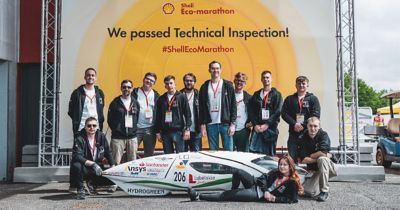-
United States -
United Kingdom -
India -
France -
Deutschland -
Italia -
日本 -
대한민국 -
中国 -
台灣
-
Ansys is committed to setting today's students up for success, by providing free simulation engineering software to students.
-
Ansys is committed to setting today's students up for success, by providing free simulation engineering software to students.
-
Ansys is committed to setting today's students up for success, by providing free simulation engineering software to students.
-
Contact Us -
Careers -
Students and Academic -
For United States and Canada
+1 844.462.6797

Twenty-five teams wait in anticipation to race their wooden vehicles. It’s 1985 in France, and these teams are about to participate in the very first Shell Eco-marathon. The goal? To travel the farthest distance using as little energy as possible, advancing the future of sustainable mobility and energy optimization.
Now, almost 40 years later, the Shell Eco-marathon continues with the same goal; however, the teams and cars participating look a little different. Instead of hosting 25 teams, the Shell Eco-marathon has expanded to become a global competition with over 300 teams participating annually. The participating teams are turning to new, innovative fuels and technologies to design, build, and drive the most energy-efficient vehicles.
One of these teams is the Hydrogreen student team from Lublin University of Technology in Poland. The Hydrogreen team is a well-established participant in the Shell Eco-marathon, having participated 10 times with over 150 members. With access to Ansys’ simulation tools through a student team partnership under the Ansys Academic Program, the team competes with its high-performance, hydrogen-powered vehicle called HYDROS. Under the guidance of professor Jacek Czarnigowski, students apply the knowledge and skills they have acquired in their studies to develop the car, which also enables them to deepen their knowledge. Through this experience, the students have the unique chance to not only work with emerging technology but become empowered to think creatively, Czarnigowski says.
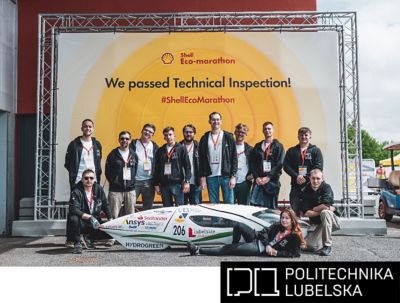
The Hydrogreen student team with HYDROS (top) and its logo (bottom)
Over a decade of participation, the Hydrogreen team has taken HYDROS from a sketch on a piece of paper to a functional vehicle that is constantly being improved upon in terms of mechanics, electronics, and control.
Rapidly Adapting to Change With Ansys Solutions
HYDROS’ complex design has continuously evolved over time. Today, Czarnigowski shares that HYDROS consists of two independent electrical systems with three energy sources — a lithium-ion battery, supercapacitors, and a hydrogen fuel cell — that drive several power consumers and are distributed around the vehicle. When updating the design each year, the team focuses on:
- Meeting the strict safety requirements that come with using hydrogen fuel.
- Minimizing the energy consumption for every trip, thus aligning with the goals of the Shell Eco-marathon. This involves both efficiently managing the energy flow and consuming the least amount of energy possible.
“These requirements mean that designing the architecture of such a system requires very good planning,” says Czarnigowski. To achieve this safe, effective design, the Hydrogreen team chose the Ansys SCADE embedded software product collection, mainly using the Ansys SCADE Architect systems and software architecture modeling application in the past year.
“Ansys SCADE Architect simulation software allows us to design our system in a way that ensures flexibility to change, the possibility of group work, and — most importantly — compliance with the security requirements of embedded systems,” says Czarnigowski. Using this software, the team designed and developed HYDROS’ vehicle control and management software (VCMS). And this wasn’t the end of the use of simulation for this year’s competition.
For its first step as a participant in the Shell Eco-marathon, the Hydrogreen team needed to pass the technical verification stage, which investigates the whole system of the HYDROS vehicle. This stage was particularly challenging this year since the judges made a few last-minute rule changes, such as forbidding carbon-fiber wheels and addressing safety concerns around hydrogen leakage.
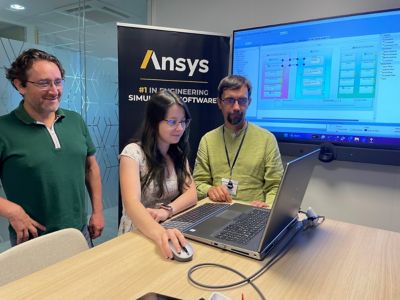
The Hydrogreen team using Ansys simulation software
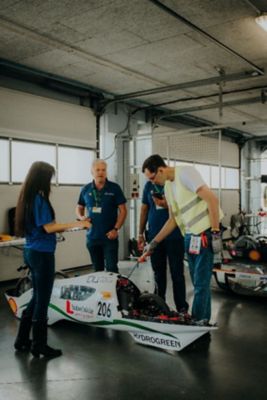
HYDROS being inspected at the Shell Eco-marathon
Despite this hurdle, the Hydrogreen team rapidly adapted and proved that its design was safe by showcasing its simulation results. By using SCADE solutions, the team easily updated its design and produced good documentation for each change requested by the judges. “A well-developed and well-documented architecture helped us pass the inspection,” says Czarnigowski.
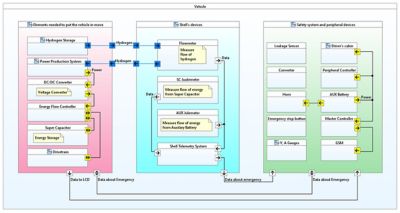
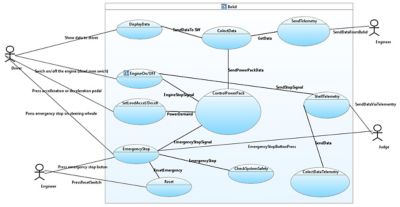
Graphics depicting how HYDROS functions
As a result, out of the 14 cars intending to take part in the marathon this year, the Hydrogreen team was one of only 10 that passed these challenging requirements. Not only did it pass, but Weronika Nowak, a driver on the team with an IT specialty, shares that it was one of the first teams to pass the technical inspection.
Using the Power of Simulation To Collaborate Across Disciplines
Making HYDROS successful requires a wide range of skill sets. “The team brings together students from mechanical engineering, electrical engineering, computer science, mechatronics, environmental protection, marketing, management, and basic engineering to work toward a common goal,” says Czarnigowski.
In a group like this, team members often approach problems from different directions and use the languages of different disciplines. SCADE solutions serve as a great tool for the Hydrogreen team to better communicate and collaborate. With its SCADE models, the team could have its system design all in one place and better share information between different groups.

The Hydrogreen team collaborating

In this way, Czarnigowski says SCADE solutions form a “common language” among students, enabling the whole group, no matter the discipline, to experience the fun of science.

Preparing to drive HYDROS
Advancing Careers and the HYDROS Design
When asked about the Hydrogreen team’s next steps, Czarnigowski says it is going to build HYDROS 2.0. To do so, team members plan on expanding their use of Ansys products to include Ansys Fluent fluid simulation software to design and optimize the car body; Ansys Mechanical structural finite element analysis (FEA) analysis software to design a lightweight, durable monocoque structure, suspension, and control system; and Ansys SCADE Suite and SCADE Display model-based design tools to design control code and human-machine interface components and then automatically generate the corresponding code to be executed in the HYDRO 2.0 prototype. In particular, the team plans to develop algorithms for controlling energy flow in conjunction with system safety, says Czarnigowski. Through this, the team hopes to optimize performance and improve results.
As for the students themselves, team members often use the experiences they gained during this project as stepping stones to careers in this field. “Participation in the prestigious Shell Eco-marathon competition and the Hydrogreen team, which is well known in Poland, opens up opportunities for internships and later employment in good companies all over the world,” Czarnigowski says.
The teamwork, self-confidence, ability to work under pressure, experience in interdisciplinary collaboration, and time management skills gained are also of great importance.
Looking to the future, Lublin University of Technology also hopes to support more women as they consider careers in technology. As such, the university is launching a mentorship program and hopes to have talented students like Nowak inspire women who are interested in science, technology, engineering, and mathematics (STEM) careers, such as those pursued by the Hydrogreen team.
Ansys also makes it a priority to help advance STEM education and empower students with accessible, affordable simulation tools. Want to learn more? Read about Ansys Student design team partnerships.
“Ansys SCADE Architect simulation software allows us to design our system in a way that ensures flexibility to change, the possibility of group work, and — most importantly — compliance with the security requirements of embedded systems.”
— Jacek Czarnigowski, professor, Lublin University of Technology
The Advantage Blog
The Ansys Advantage blog, featuring contributions from Ansys and other technology experts, keeps you updated on how Ansys simulation is powering innovation that drives human advancement.














